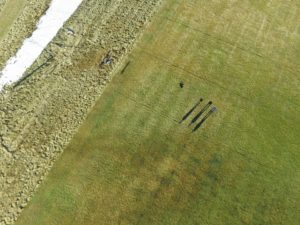 Members of the AU Drone Club (SaxonFly) further refined their flight skills at Jericho Hill today – commercial flights coming soon.
Members of the AU Drone Club (SaxonFly) further refined their flight skills at Jericho Hill today – commercial flights coming soon.

Law and Taxation: See the Forest and the Trees
Assistant Professor Luis Rodriguez Jr. at Alfred University
A group of intrepid Alfred University Drone Club (SaxonFly) members met at Jericho Hill today to fly their Phantom 3 Professional drone. The group of five flew for about an hour, testing and improving their flight skills on this windy day – nothing like field testing to get the heart pumping!

SaxonFly’s President and Vice-President, Eric Witowski (Senior, Mechanical Engineering) and Jason St. John (Junior, Finance), aim for weekly flights as they move forward to develop photographic, and precision agricultural commercial applications for their drones in Alleghany County and Steuben County. Eric also mentioned that he hopes to work with the local high school STEM (Science, Technology, Engineering, and Math) training programs.
Fiat Lux!
The White House Office of Science and Technology Policy (OSTP) is hosting the first-ever Workshop on Drones and the Future of Aviation, gathering experts and researchers from across industry, academia, and government for a discussion on different topic areas related to policy, research and development, and technology in unmanned aircraft systems (UAS) applications and airspace integration.
The OSTP expressed that members of their “Pathfinder” initiative expect to assist the FAA finalizing beyond-line-of-sight (BLOS) and flight over people regulations by the end of 2016.
The White House issued a fact sheet on their commitment to safe drone use across the United States.
Speakers mentioned that drone use generally fall within three categories:
New York State is active in these efforts.
Effective August 29, 2016 the FAA’s new drone regulations will permit small drones to be operated commercially by eligible pilots that are certified. Those not already holding a pilot certificate may become certified by passing the initial aeronautical knowledge test at an FAA-approved knowledge testing center.
That test will cover the following:
The FAA released a Sample Drone Exam as a study guide.
Reference Material:
Prior Posts:
The FAA recently made small drones easier to use commercially; however, many don’t know that in May 4, 2016 the FAA also provided guidance for their educational use freeing faculty and students to more fully embrace this new technology. Drones are a popular and affordable technology that can draw students into careers in science, technology, engineering, and mathematics (STEM). They can easily be used to creatively teach mathematics, electronics, programing, materials and battery and optical engineering in addition to business subjects such as marketing, finance, and management. The science behind flight is much easier to teach when students can apply the lesson in a lab just outside their classroom, and it’s here that small rural universities have an edge.
Small rural universities have the open space that drones require to operate, a large advantage over their urban counterparts. Importantly, drones can give students the practical experience they need by helping the local agricultural, construction, photography, and business community.
In short, drones are here to stay and small rural universities are well positioned to serve their students and communities by fully embracing this technology.
Having done good work with recently finalized Part 107 drone regulations, the FAA should now move forward with rules for those who want to pilot micro drones (under 4.4 pounds) by reviewing the micro-UAS ARC report dated April 1, 2016, and also for those who want to pilot drones beyond visual line of sight, or at night – these are major issues for those who want to use drones in agriculture, land delivery, and ship-to-shore delivery services.